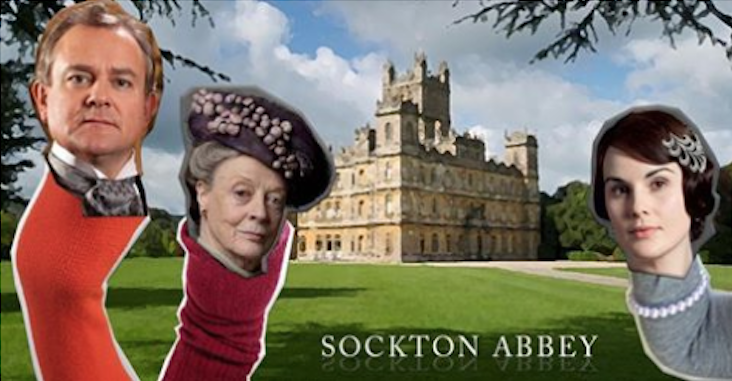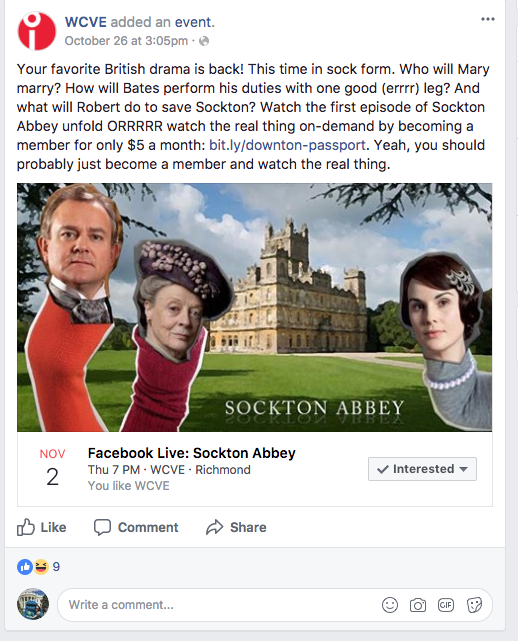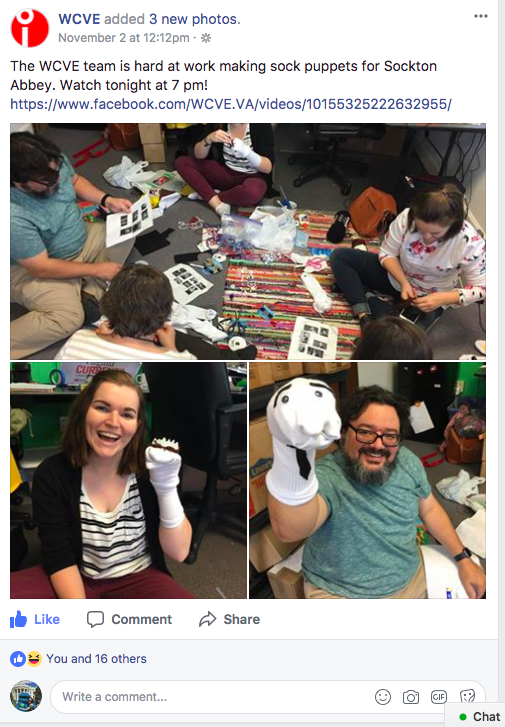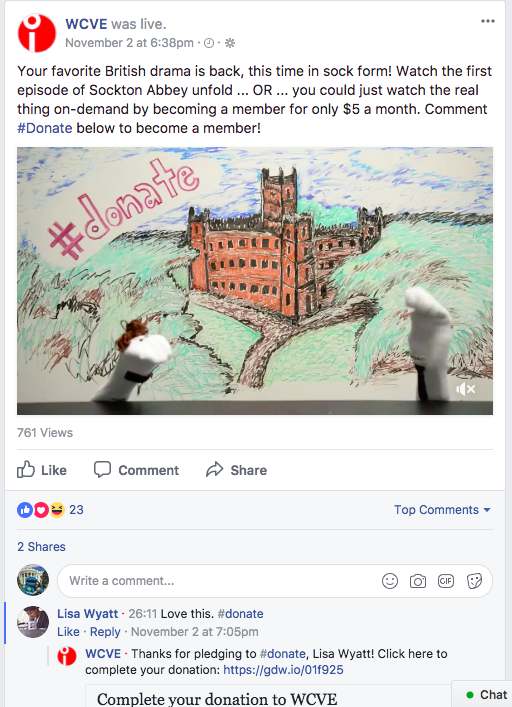VPM’s Facebook Live “Sockton Abbey” Engages Audiences During Passport #donate Pilot

VPM’s Facebook Live “Sockton Abbey” Engages Audiences During Passport #donate Pilot
To continue promoting Passport as a member benefit and take advantage of #donate technology on social media, PBS recently launched a Passport #donate Pilot for 14 member stations. The goal was to test Passport as an online fundraising tool to convert social media followers to donors. Each participating station experimented with Facebook posts and videos encouraging followers to contribute $5 a month to become sustainers (by commenting on a post with “#donate $5) or to contribute $60 a year for annual membership. While stations in the pilot program attended a webinar and were given a toolkit of sample Facebook posts, they were encouraged to customize images, use video and Facebook live, and otherwise be as creative as possible.
Sockton Abbey

One of the most original approaches came from VPM, one of central Virginia’s Community Idea Stations, guided by social media manager Angela Massino. “One of the examples in the webinar was that churches were using Facebook live, talking about a topic and asking people to donate for that topic,” she says. A few webinar participants mentioned using FB live to explain the #donate technology.
“But we are always wanting to approach a project with content first,” says Massino. “Why are we doing this? What type of content will get people to take action?” Rather than an explanatory video, she wanted to produce something compelling enough that people might watch it for the content alone.
In one brainstorming session, a colleague mentioned a local theater in Richmond that had been doing dramatic readings of scripts from television shows. That led to someone jokingly suggesting they perform a Downton Abbey script. “Downton Abbey is extremely popular in Richmond,” says Massino.
At the same time, another collaborator had seen a local theater build a promotion around sock puppets. The VPM team pulled these random threads into a creative tapestry: a Facebook Live video that promoted Passport and #donate via a reading of a Downton Abbey script using sock puppets.
“That’s when Sockton Abbey was created,” Massino says. “Something that took a minimal amount of effort and planning but could give us an hour-and-a-half Facebook Live.”
Going Live

Tasking interns and part-time staff with making the sock puppets, Massino’s team adapted a script to accommodate a single camera angle, pulled in a couple of volunteers, assigned parts, scheduled a single run-through of the script, and then went live.
“We scheduled commercial breaks during the show,” she says. “Our big messaging point was ‘We can’t believe you’re still watching this. You could be watching the real thing by donating now. Don’t watch adults play with sock puppets! Watch all six seasons!”
While most viewers were popping in and out of the live feed for an average watch time of 32 seconds, the video amassed 782 views, 912 total minutes viewed, and 16 live viewers at its peak. The post itself reached 2,199 people and earned 82 reactions, comments and shares.
In addition to the Facebook Live video, WCVE also edited out and captioned a portion of the performance. The average watch time and overall engagement was higher on the Facebook Live video, but the edited clip had a wider reach (2,338 people reached and 1,063 views).
Both videos satisfied Massino, who chooses Facebook Live over edited videos depending on the content and the goals. If the number-one goal is engagement, she prefers a live video. “We know the Facebook algorithm is weighted toward live videos and so a produced video doesn’t do as well,” she says. “When you have something that’s live and looks live, people enjoy that. But certain videos—if action-oriented or captioned—do really well as produced videos on Facebook. It all depends on what you’re trying to get out of it.”
Engagement versus Dollars

VPMand “Sockton Abbey” definitely got engagement in the #donate experiment, but did it result in actual donations? Well, no. “It didn’t make a ton of money,” says Massino. Altogether, it raised $30.
She thinks audience unfamiliarity with #donate technology or the complexity of the system may have hurt the campaign—which is one reason a number of pilot stations wanted to create video explainers about how it works in the first place. “I want to get people to the content as quickly as possible, with the least amount of steps as possible,” she says. With this campaign, that content was Passport and real episodes of Downton Abbey. “Any time you have to explain to somebody how to use a piece of technology, you’re already behind. With #donate, they have to do the hashtag, then they get a link which they have to click on, and after completing the form they get the code—there’s a couple of steps.”
Massino wonders if the push to Passport through #donate wasn’t the best pairing. “Our messaging for #donate ended up being all about Passport but then people weren’t getting that instant gratification of Passport,” due to the hurdles of following the #donate procedure. “If our messaging was more about community than something you get, maybe that would have done better.”
Keepin’ it Quirky
Regardless, they believe the quirky, creative content approach worked well for the WCVE audience. “Richmond’s kind of quirky so they enjoy quirky things,” she says. But that doesn’t mean there will be a Sockton Abbey 2. “That’s just silly. All of a sudden you’re taking something that was made to be fun and simple and trying to create a thing out of it,” she says. With social media, Massino says, people need to be comfortable with one-time experiments based on what’s trending or popular. “We need to go through the same process: What is our goal with this? What does our community respond to? How do they feel connected to our goal or the content? The process will always be the same.”
And whether it’s always a financial success or not, she believes VPM definitely needs to continue innovating with digital fundraising. “This is a space we need to be in,” says Massino. “Traditional nonprofits are doing it very, very well. We should start looking at the techniques and approaches they’re taking and adopt them for ourselves and for our purposes.”
